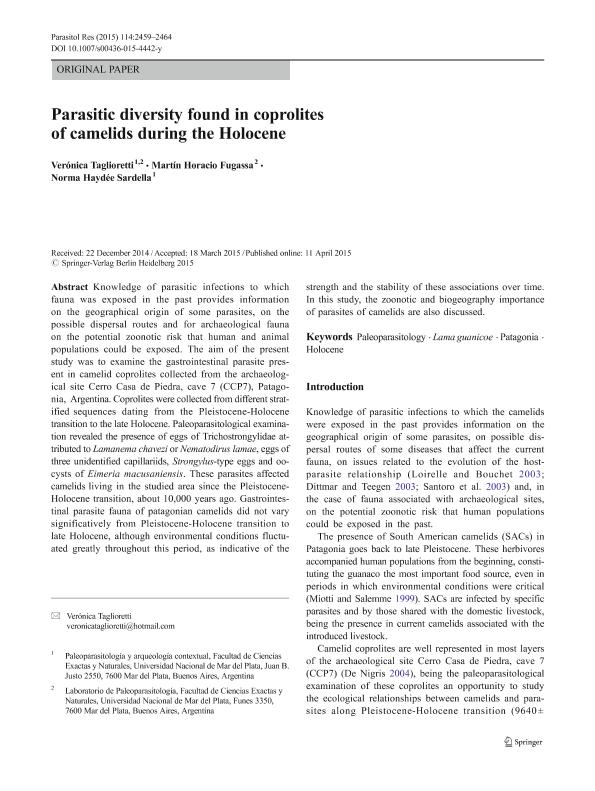Mostrar el registro sencillo del ítem
dc.contributor.author
Taglioretti, Verónica

dc.contributor.author
Fugassa, Martín Horacio

dc.contributor.author
Sardella, Norma Haydee

dc.date.available
2018-06-29T17:57:56Z
dc.date.issued
2015-07
dc.identifier.citation
Taglioretti, Verónica; Fugassa, Martín Horacio; Sardella, Norma Haydee; Parasitic diversity found in coprolites of camelids during the Holocene; Springer; Parasitology Research; 114; 7; 7-2015; 2459-2464
dc.identifier.issn
0932-0113
dc.identifier.uri
http://hdl.handle.net/11336/50724
dc.description.abstract
Knowledge of parasitic infections to which fauna was exposed in the past provides information on the geographical origin of some parasites, on the possible dispersal routes and for archaeological fauna on the potential zoonotic risk that human and animal populations could be exposed. The aim of the present study was to examine the gastrointestinal parasite present in camelid coprolites collected from the archaeological site Cerro Casa de Piedra, cave 7 (CCP7), Patagonia, Argentina. Coprolites were collected from different stratified sequences dating from the Pleistocene-Holocene transition to the late Holocene. Paleoparasitological examination revealed the presence of eggs of Trichostrongylidae attributed to Lamanema chavezi or Nematodirus lamae, eggs of three unidentified capillariids, Strongylus-type eggs and oocysts of Eimeria macusaniensis. These parasites affected camelids living in the studied area since the Pleistocene-Holocene transition, about 10,000 years ago. Gastrointestinal parasite fauna of patagonian camelids did not vary significatively from Pleistocene-Holocene transition to late Holocene, although environmental conditions fluctuated greatly throughout this period, as indicative of the strength and the stability of these associations over time. In this study, the zoonotic and biogeography importance of parasites of camelids are also discussed.
dc.format
application/pdf
dc.language.iso
eng
dc.publisher
Springer

dc.rights
info:eu-repo/semantics/openAccess
dc.rights.uri
https://creativecommons.org/licenses/by-nc-sa/2.5/ar/
dc.subject
Holocene
dc.subject
Lama Guanicoe
dc.subject
Paleoparasitology
dc.subject
Patagonia
dc.subject.classification
Otras Ciencias Biológicas

dc.subject.classification
Ciencias Biológicas

dc.subject.classification
CIENCIAS NATURALES Y EXACTAS

dc.title
Parasitic diversity found in coprolites of camelids during the Holocene
dc.type
info:eu-repo/semantics/article
dc.type
info:ar-repo/semantics/artículo
dc.type
info:eu-repo/semantics/publishedVersion
dc.date.updated
2018-06-29T13:10:22Z
dc.identifier.eissn
1432-1955
dc.journal.volume
114
dc.journal.number
7
dc.journal.pagination
2459-2464
dc.journal.pais
Alemania

dc.journal.ciudad
Berlin
dc.description.fil
Fil: Taglioretti, Verónica. Universidad Nacional de Mar del Plata. Facultad de Ciencias Exactas y Naturales; Argentina. Consejo Nacional de Investigaciones Científicas y Técnicas; Argentina
dc.description.fil
Fil: Fugassa, Martín Horacio. Universidad Nacional de Mar del Plata. Facultad de Ciencias Exactas y Naturales; Argentina. Consejo Nacional de Investigaciones Científicas y Técnicas; Argentina
dc.description.fil
Fil: Sardella, Norma Haydee. Universidad Nacional de Mar del Plata. Facultad de Ciencias Exactas y Naturales; Argentina. Consejo Nacional de Investigaciones Científicas y Técnicas; Argentina
dc.journal.title
Parasitology Research

dc.relation.alternativeid
info:eu-repo/semantics/altIdentifier/doi/http://dx.doi.org/10.1007/s00436-015-4442-y
dc.relation.alternativeid
info:eu-repo/semantics/altIdentifier/url/https://link.springer.com/article/10.1007%2Fs00436-015-4442-y
Archivos asociados
